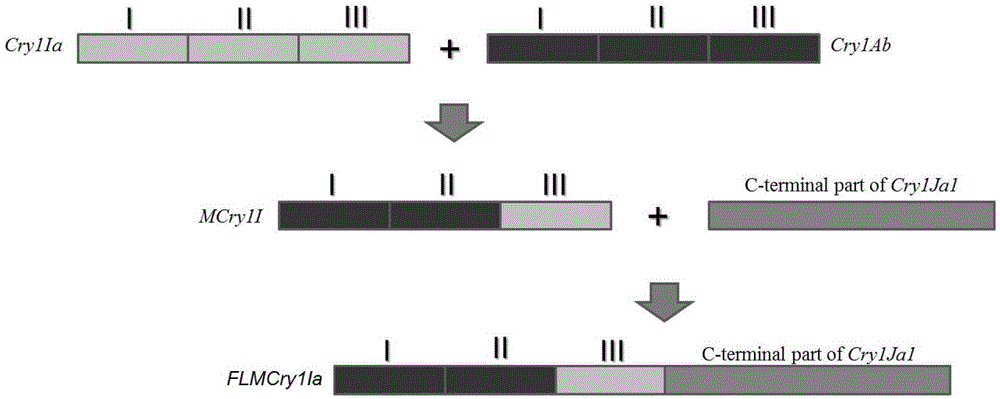Artificially synthesized Bt insecticidal gene FLIa as well as preparation method and application thereof
An anti-insect gene, artificial synthesis technology, applied in the directions of botanical equipment and methods, biochemical equipment and methods, applications, etc., to achieve important economic value, reduce environmental pollution, and broad application prospects.
- Summary
- Abstract
- Description
- Claims
- Application Information
AI Technical Summary
Problems solved by technology
Method used
Image
Examples
preparation example Construction
[0040] The invention provides a method for preparing the above-mentioned artificially synthesized Bt insect-resistant gene FLIa, comprising the following steps:
[0041] Step 1: Exchange and fuse Domain I and Domain II of the insect-resistant gene Cry1Ab with Domain III of the insect-resistant gene Cry1Ia to obtain the recombinant insect-resistant gene MCry1I.
[0042] Step 2. On the basis of the recombined insect-resistant gene MCry1I, connect the carbon terminus of the insect-resistant gene Cry1Ja1 at the 3' end to obtain the recombined insect-resistant gene FLMCry1Ia; the recombined insect-resistant gene FLMCry1Ia has the greatest homology with the amino acid sequence of the Cry gene was 88%.
[0043] Step 3: Transform the codons of the recombinant insect-resistant gene FLMCry1Ia to obtain the Bt insect-resistant gene FLIa, the nucleotide sequence of which is shown in SEQ ID NO: 1 in the sequence listing. The codon transformation of the recombinant insect-resistant gene FL...
Embodiment 1
[0049] Example 1 The acquisition of novel insect-resistant gene FLIa
[0050] DomainⅢ is the recognition region between Cry protein and receptor protein, and is the main functional region to determine the target. By exchanging DomainⅢ domains between Cry proteins with different insecticidal spectrums, the insecticidal spectrum of insecticidal proteins can be increased.
[0051] Such as figure 1 As shown, in the present invention, Domain I and Domain II of insect-resistant gene Cry1Ab are exchanged and fused with Domain III of insect-resistant gene Cry1Ia to obtain recombinant insect-resistant gene MCry1I. In order to increase the stability of gene expression, on the basis of the recombinant insect-resistant gene MCry1I, the carbon terminus of the insect-resistant gene Cry1Ja1 was connected at the 3' end to obtain the recombinant insect-resistant gene FLMCry1Ia. The maximum homology of amino acid sequence of Cry gene is 88%.
[0052] In order to further improve the insect-res...
Embodiment 2
[0053] Embodiment 2 Construction of novel insect-resistant gene FLIa plant expression vector
[0054] Such as figure 2 As shown, digest the plant expression vector pCAMBIA3300 with EcoRI and HindIII, reclaim the fragment ubi-nos between the restriction sites, and connect it into the EcoRI and HindIII sites of the plant expression vector pTF101.1 (such as image 3 shown), construct the plant expression vector pTF101.1-ubi (such as Figure 4 shown). The artificially synthesized Bt insect-resistant gene FLIa with SmaI and SacI restriction sites at both ends was connected between the SmaI and SacI sites of the plant expression vector pTF101.1-ubi to construct a plant expression vector for the insect-resistant gene FLIa ( Such as Figure 5 shown), the plant expression vector was named pTF101.1-ubi-FLIa, and its nucleotide sequence is shown in SEQ ID NO:3.
[0055] The constructed plant expression vector pTF101.1-ubi-FLIa includes: P35S promoter, TEV enhancer, bar gene, soybean...
PUM
 Login to View More
Login to View More Abstract
Description
Claims
Application Information
 Login to View More
Login to View More - R&D
- Intellectual Property
- Life Sciences
- Materials
- Tech Scout
- Unparalleled Data Quality
- Higher Quality Content
- 60% Fewer Hallucinations
Browse by: Latest US Patents, China's latest patents, Technical Efficacy Thesaurus, Application Domain, Technology Topic, Popular Technical Reports.
© 2025 PatSnap. All rights reserved.Legal|Privacy policy|Modern Slavery Act Transparency Statement|Sitemap|About US| Contact US: help@patsnap.com



